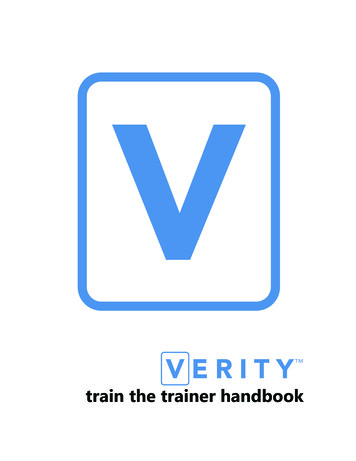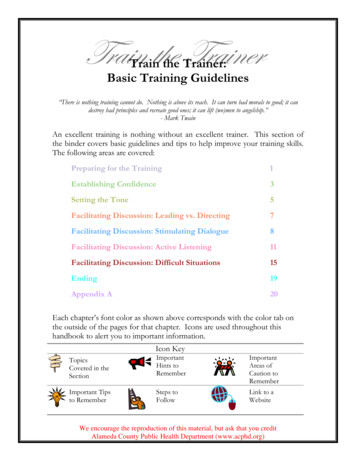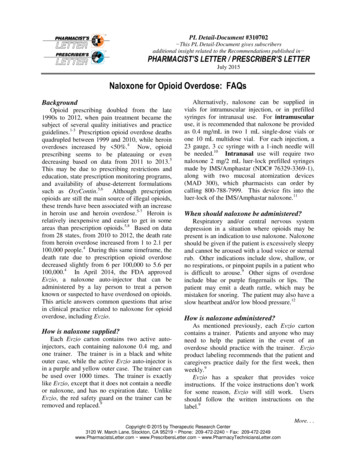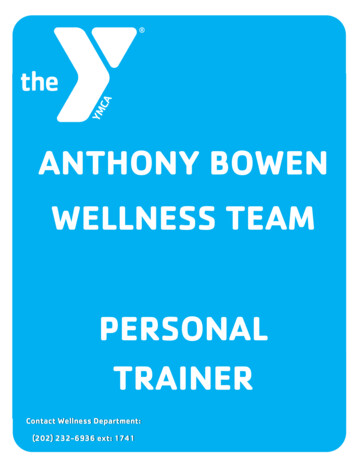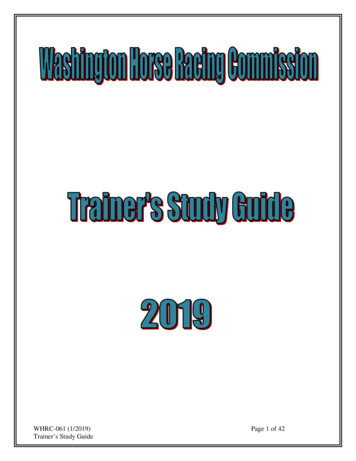
Transcription
TRAIN THE TRAINERTrainTheTrainer“Transferring skills and knowledge”T3A Port of San Diego Ship Repair AssociationCourse for Shipyard WorkersThis material was produced under grant SH-27645-SH5 from the Occupational Safety and HealthAdministration, U.S. Department of Labor. It does not necessarily reflect the views or policies of theU.S. Department of Labor, nor does mention of trade names, commercial products or organizationsimply endorsement by the U.S. Government.
TRAIN THE TRAINERTRAIN THE TRAINER“You can help aperson catch afish and feedthem for a dayor you canteach a personhow to fish andthey can feedthemselves fora lifetime.”2
TRAIN THE TRAINEREMPLOYEEDEVELOPMENT“I believe the desire and ability of an organization tocontinuously learn from any source, anywhere, andrapidly convert this learning into action is its ultimatecompetitive advantage.” Jack Welch, Former-CEOGeneral Electric Company.The skills and knowledge an organization possesses isfast becoming recognized as its most important asset.A key element of organizational excellence is the skilland knowledge its employees possess. To fullyempower an individual, that individual must have theability to be empowered.To hold employeesaccountable, they must be capable of performing theactivity or the job.The purpose of this course is to build upon yourability to train others.3
TRAIN THE TRAINERDEFINING TRAINING“An organized activity designedto bring about change.”CLASSROOMON-THE-JOB4
TRAIN THE TRAINERTRAINING TOPICS Learning Principles Training Development Training in a Classroom5
TRAIN THE TRAINERTHINK OF SOMETHINGYOU LEARNED!WHY DID YOU LEARN?HOW DID YOU LEARN?6
TRAIN THE TRAINERCOURSE OBJECTIVESUpon completion of this training course, thelearners will have the ability to: Demonstrate four qualities of a goodtrainer List four things to prepare for training Conduct a Training Needs Assessment Put training into context Write training objectives Develop a detailed training outline Develop methods for the trainee to practice Create an effective learning environment Use two types of classroom training mediaeffectively Use four participative training methods Assess training effectiveness7
TRAIN THE TRAINERTHE QUALITIES OF AGOOD TRAINER“The mediocre teacher tells. Thegood teacher explains. The superiorteacher demonstrates. The greatteacher inspires.”- William Arthur Ward8
TRAIN THE 24420342133352236462342111121048479
TRAIN THE TRAINERA GOOD TRAINERWHAT I DIDWHAT IS THEOPPOSITE!10
TRAIN THE TRAINERTRAINERCHARACTERISTICS Speaks clearlyOrganizedApproachablePatientUses a consistent approachReads their leGood ListenerDoesn’t “downplay” task (this is easy)Has a positive attitudeMakes others feel comfortableGives positive feedback11
TRAIN THE TRAINERYOUR “TRAINER”RESPONSIBILITIESAs a trainer, please list below what you believe yourresponsibilities to be:12
TRAIN THE TRAINERA KEY TRAINERRESPONSBILITYCreating a Learning Environment!13
TRAIN THE TRAINERCREATING A LEARNINGENVIRONMENTListenEncourage InvolvementHave PatienceTransition Skill Right Away14
TRAIN THE TRAINERCREATING A LEARNINGENVIRONMENTDon’t RushOverwhelmDoubtCompare15
TRAIN THE TRAINERPREPARING FORTRAINING“You can’t drive a car by lookingin the rear view mirror.”- Deming16
TRAIN THE TRAINERPREPARATION KEYELEMENTS Know the Material/Task Know skill/knowledge level of trainees “Walk Through” the Task/Material Establish the Physical Environment Design and Use a Checklist Anticipate Questions17
TRAIN THE TRAINERSAMPLE CHECKLIST Trainer’s Guide (Notes) Trainee Books Handout Notepaper Pens LCD Projector LCD Screen Lap Top Computer with course and videos All Cord(s) Two Flipchart Stands Two Flipchart Pads Set of Flipchart Markers Masking Tape Feedback Handout18
TRAIN THE TRAINERYOUR CHECKLISTCOURSE TITLE: 19
TRAIN THE TRAINERWHAT PEOPLEREMEMBER!Verbal Read Hear wordsVisual Look at pictures Watch an eventSee and Hear Watch and listen to a demonstration Watch a videoSay or Write Take notes Explain a procedureKinesthetic (Experiential) Simulate an experience Do the real thing20
TRAIN THE TRAINERTRAININGDEVELOPMENT Determine Training Needs Training Needs Assessment Provide Context Course Overview Put Into Digestible Chunks Course Outline Practice, Practice, Practice! People learn by doing Provide On-going Feedback Acknowledge your participants!21
TRAIN THE TRAINERTRAINING NEEDSASSESSMENT Hard Copy – All or select number ofemployees– Conducted in meetings, drop-box ormail in Hard Copy – Focus Group– Key 6-7 individuals Electronic Survey– Free or Pay22
TRAIN THE TRAINERTHE PROS AND CONSHARD COPYPROSCONSHARD COPY FOCUS-GROUPPROSCONSELECTRONICPROSCONS23
TRAIN THE TRAINERTRAINING ASSESSMENTCOVER MEMOOur company has been selected and is participating in aTraining Program in partnership with the Port of San DiegoShip Repair Association and OSHA’s Susan HarwoodProgram.In order to best determine which training to provide to ouremployees, we would appreciate if you would complete andreturn the attached Training Needs Assessment Form to:Insert trainer name or POC hereon or before .We plan to have our training class during the month ofJanuary, 2016.If you have any questions or comments, please let me know.Thank you for your input.Signed,Trainer from your company24
TRAIN THE TRAINERTRAINING ASSESSMENTMETHOD ONEHard Copy – All or a select number ofemployees Expect 30% return Return to trainer, drop-box orpoint of contact for roll up Increases “buy-in” Can be done through aninterview one-on-one or focusgroup (see next method)25
TRAIN THE TRAINERTRAINING ASSESSMENTMETHOD TWOHard Copy – Focus Group Groups of 6-7 Allows discussion Work Group representation Faster implementation Faster roll-up Less buy-in from participants26
TRAIN THE TRAINERTRAINING ASSESSMENTMETHOD THREEElectronic Surveys Survey Monkey – commonlyused Results to trainer or POC Results done within survey tool Specifics to be found onAssessment Tool Websites27
TRAIN THE TRAINERELECTRONIC SURVEYS Electronic surveys have many advantages overtraditional surveys, including a reduction in costand ease of analysis. Drawbacks to this type of datacollection include the potential for selection biasand poorer response rates. The fast, efficient and often 'free' electronic surveyhas many advantages over the traditional postal datacollection method, including ease of analysis forwhat can be vast amounts of data. However, tocapitalize on these benefits, researchers mustcarefully consider techniques to maximize responserates and minimize selection bias for their targetpopulation.28
TRAIN THE TRAINERSTRATEGIES Easily accessible link Stating the length Stating the population Sending up to three reminders Personalizing each email Adding the updated response rate toreminder emails Stating the average time it would take tocomplete the survey in the title of the email29
TRAIN THE TRAINERTRAINING NEEDSASSESSMENTSample Assessment30
TRAIN THE TRAINERASSESSMENT ROLL-UP2013 Training Needs Assessment (Arranged By Highest Rating Average)1. Locking and Tagging-Out SafelyRating2. Working In and Around Confined SpacesRating3. Preventing Fires and Performing Hot WorkRating3. 10-Hour OSHA (7615)Rating3. Performing a Hazard AssessmentRating4. Creating a Safety CultureRating4. Performing a Job Safety AnalysisRating4. Protecting Yourself From FallsRating5. Applying Personal Protective Equipment (PPE)RatingNot BeneficialSomewhatBeneficialBeneficial007Not BeneficialSomewhatBeneficialBeneficial105Not BeneficialSomewhatBeneficialBeneficial108Not BeneficialSomewhatBeneficialBeneficial027Not BeneficialSomewhatBeneficialBeneficial108Not BeneficialSomewhatBeneficialBeneficial125Not BeneficialSomewhatBeneficialBeneficial028Not BeneficialSomewhatBeneficialBeneficial117Not BeneficialSomewhatBeneficialBeneficial037Very Beneficial Rating Average213.75Very Beneficial Rating Average223.71Very Beneficial Rating Average193.61Very Beneficial Rating Average193.61Very Beneficial Rating Average193.61Very Beneficial Rating Average203.57Very Beneficial Rating Average183.57Very Beneficial Rating Average193.57Very Beneficial Rating Average183.5431
TRAIN THE TRAINERSAFETY TRAININGRESULTSThe top 8 safety training needs are listed below by highestaverage score. (Average score in parentheses.)1. Locking and Tagging-Out Safely (3.75)2. Working In and Around Confined Spaces (3.71)3. Preventing Fires and Performing Hot Work (3.61)4. 10-Hour OSHA (7615) (3.61)5. Performing a Hazard Assessment (3.61)6. Creating a Safety Culture (3.57)7. Performing a Job Safety Analysis (3.57)8. Protecting Yourself From Falls (3.57)32
TRAIN THE TRAINEROBJECTIVES SO FAR Demonstrate four qualities of a goodtrainer List four things to prepare for training Conduct a Training Needs AssessmentDescribe:33
TRAIN THE TRAINERFROM THE TRAINER TOTHE TRAINEE“The most important component ofeffective training is what your people takeaway from it.”- Dr. Jerry Mcardle34
TRAIN THE TRAINERCONTEXT1. How does the task fit into thebigger picture?2. What happens before the task?3. What happens after the task?4. What could go wrong?5. Background/Importance6. Relevance to Trainee35
TRAIN THE TRAINERTOO DETAILED TOSTART36
TRAIN THE TRAINERBIGGER PICTURE37
TRAIN THE TRAINERELEMENTS OF ACOURSE OVERVIEW1. Course Purpose2. Course Objectives3. Trainee Preparation4. Training Modules5. Background/Importance6. Relevance to Trainee38
TRAIN THE TRAINERCOURSE OVERVIEWInstalling a TRACKS TerminalCourse PurposeAt the end of this course you will be able to install a TRACKS TerminalCourse ObjectivesAfter completing this course, without help,you will be able to:1. Describe Installation Process.2. Identify all Tools and Materials Needed toInstall TRACKS Terminal.3. Install the Terminal Unit.4. Install the Antenna.5. Install Electrical Hook-Ups.6. Test Unit for Proper Functioning.Trainee PreparationRead installation instructions and be familiar withthe Installation Kit and where it will be mounted.Training Modules1. Installing the Terminal Unit.2. Installing the Antenna.3. Installing Electrical Hook-Ups.Background/Importance TRACKS– Is an Internet-based service that provides location and status information onheavy equipment. It is a key product/service delivered by our company andsales are on the rise!Training Relevance Certification in this module is required for you to perform this task.39
TRAIN THE TRAINERPURPOSE ANDOBJECTIVES What is the difference?40
TRAIN THE TRAINERLEARNING OBJECTIVESEstablish clear-cut, competency-based learningobjectives that describe what the learner will be ableto do at the end of the training presentation.What is a learning objective?A learning objective is a statement describing alearning outcome, rather than a learning process orprocedure. It describes results, rather than the meansof achieving those results.Why do we need to write objectives? They help the instructor design and selectinstructional content and procedures They provide clear expectations for the learner They help the instructor evaluate or assess thesuccess of instruction41
TRAIN THE TRAINEROBJECTIVE CRITERIA1. The objective states a time limit2. The objective specifiesconditions of performance3. The objective identifies theperformer(s)4. The objective contains oneaction verb5. The objective specifies anacceptable standard ofperformance42
TRAIN THE TRAINERTHE 5 CRITERIAListed below are the five criteria for writingeffective training objectives.“(1) At the end of the training session, (2) givenlockout/tagout equipment and without help, (3)you will (4) perform (5) all of the steps of thechipper lockout/tagout procedure without error.“1.The objective states a time limit. "At the end ofthe training session“2.The objective specifies the conditions ofperformance. “given lockout/tagout equipmentand without help“3.The objective identifies the performer. "you"4.The objective contains one or more action verbs.“perform“5.The objective specifies an acceptable standard ofperformance. "all steps, without error.“43
TRAIN THE TRAINEROBJECTIVE EXERCISEGroup Exercise: From page 30 evaluate the objectives and rate below.Course ObjectivesAfter completing this course, without help,you will be able to:1. Describe Installation Process.2. Identify all Tools and Materials Needed toInstall TRACS Terminal.3. Install the Terminal Unit.4. Install the Antenna.5. Install Electrical Hook-Ups.6. Test Unit for Proper Functioning.Objective meets standards Does not meet standardsMissing criteria number(s): 1234544
TRAIN THE TRAINEROBJECTIVE EXERCISE IIGroup Exercise: Analyze each of the following objectives to determineif they measure up to the five criteria. If they do not, circle the numberof the missing criteria.1.2.3.4.5.The objective states a time limitThe objective specifies conditions of performanceThe objective identifies the performer(s)The objective contains one action verbThe objective specifies an acceptable standard of performance"Gain a greater awareness of our hazard communications program."Objective meets standards Does not meet standardsMissing criteria number(s): 12345“You will be able to rate, with justification, each element of thecompany’s hazard communications program."Objective meets standards Does not meet standardsMissing criteria number(s): 12345“At the end of the training session, given a simulated accident report,learners will be able to identify at least three possible root causescontributing to the accident.”Objective meets standards Does not meet standardsMissing criteria number(s): 1234545
TRAIN THE TRAINERACTION WORDSAction verbs describe observable/measurable behaviors. Useaction verbs when writing objectives.Comprehension:Interpret information in one'sown rttelltranslateAnalysis:Break down knowledge intoparts and show relationshipsamong comparecontrastcriticizediagramKnowledge:Recall information . . . . . . . . . . . . . . . . . . . . . . . . . istmatchrecallreproduceSynthesis:Bring together parts ofknowledge to form a wholeand build relationships fornew eset upsynthesizewriteApplication:Use knowledge in a tEvaluation:Make judgments on basis ofgiven rtvalue46
TRAIN THE TRAINERSAMPLE OBJECTIVESTraining Objectives:At the completion of this module, without help, thetrainee will be able to: Accurately describe the 6 key elements of anEmergency Action Plan Accurately describe the 5 key elements of a FallProtection Plan Select the proper agency for a given action whenpresented with a list of agencies Properly put on 3 types of fall protection equipment Explain the three key elements of quality Explain the key points of a quality assurancesystem Explain the key points of ISO 900147
TRAIN THE TRAINERYOUR COURSE OVERVIEWCourse TitleCourse PurposeAfter completing this module, you will be able to:Course ObjectivesAfter completing this module, you will be able to:1.2.3.4.Trainee PreparationTraining ModulesBackground/ImportanceTraining Relevance48
TRAIN THE TRAINERDIGESTIBLE CHUNKS Adults Build On What They Know49
TRAIN THE TRAINERDIGESTIBLE CHUNKS A manageable chunk of information is onethat the learner can easily process andcomprehend. Research suggests that people can bestprocess and remember no more than 5-9pieces ofinformation atone time. The humanmind willautomaticallygroup items tofacilitatememory.50
TRAIN THE TRAINERCHUNKING ANDSEQUENCING Information for each training objective should beput in digestible chunks and sequenced!51
TRAIN THE 244203421333522364623421111210484752
TRAIN THE TRAINERTHE WHOLE THING! Learn This Number53
TRAIN THE TRAINERMANAGEABLE UNITS Now Learn This NumberPhone:Address:54
TRAIN THE TRAINERMANAGEABLE UNITEXAMPLEA writer was assigned to write a policymanual containing 25 policies. Because 25exceeds the “chunking” limit of 5-9, thewriter identified three categories ofpolicies and divided the manual into thefollowing sections: Section I: Financial Policies Section II: Safety Policies Section III: Security Policies55
TRAIN THE TRAINERSEQUENCING The sequencing of training content and material isalmost as important as the content itself. It candefeat the purpose of a training program if notcarefully thought out. Trainers should beconcerned about the logical sequencing of training,because if the lesson does not unfold in a building,reinforcing way, learning will be less effective.“Don’t put the cart before the horse!”56
TRAIN THE TRAINERSEQUENCINGSTRATEGIES Basic “strategies” to consider insequencing safety training:– 1. Information should flow from the general tothe specific - Move gradually to the many andvaried specific on-the-job applications of theconcepts discussed.– 2. Information should develop from the simpleto the complex - The design should begin witha fairly simple conceptual overview of thesubject to be learned.– 3. Training concepts should move from theoryto practical application.– 4. Training may transition from known tounknown concepts, ideas, or processes.– 5. For On-the-Job Training (OJT), sequence thecontent so that it corresponds to the order inwhich the tasks are performed on the job.57
TRAIN THE TRAINERTHE ACANTHOPHOLIS Acanthopholis (meaning "spiny scales") was an armored,quadrupedal (walked on four legs), plant-eating dinosaurfrom the early Cretaceous period. Its armor was rows ofoval plates set into its skin, plus it had spikes jutting outof its neck and shoulder area along the spine. It was about15 feet long (4 m) and weighed roughly 380 kg.Acanthopholis lived during the early Cretaceous Period,about 115-91 million years ago. This huge, heavy reptilewas an herbivore (it ate only plants). It had to eat a hugeamount of low-lying plant material to sustain itself so itsgut must have been very large. It probably had afermentation compartment to aid in the digestion of thetough plant material, producing prodigious amounts ofgas. Acanthopholis was an ankylosaur, whoseintelligence (as measured by its relative brain to bodyweight, or EQ) was low among the dinosaurs.Ankylosaur track ways were found in 1996 near Sucre,Bolivia, South America showing that these hugecreatures could run at a "decent jog," according toChristian Meyer, a Swiss paleontologist working at thesite. Speed estimates are made using the distance betweenthe footprints, the animal's leg length, the pattern of thetracks, and other factors. Partial fossils have been foundin England. Acanthopholis was named by the Britishbiologist Thomas H. Huxley in 1865.58
TRAIN THE TRAINERTHE ACANTHOPHOLIS There are about 30 facts regarding the Acanthopholis. Outlinethese facts using Manageable Units and Sequencing Strategies.59
TRAIN THE TRAINERSAMPLE OUTLINETopic Two: Performance Alignment The Performance Process Establishing Trust .No Surprises! Planning For Performance Establishing Expectations– SMART Objectives– Establishing the Bar Measuring Performance Providing On-Going Feedback (Coaching) The Performance Discussion– Setting– Questioning– Agreement Action Planning Using The Process (On-The-Job-Actions)60
TRAIN THE TRAINERYOUR OUTLINE 61
TRAIN THE TRAINERPRACTICE, PRACTICEPRACTICE!“An ounce ofpractice isworth more thantons ofpreaching.”- Gandhi62
TRAIN THE TRAINERPRACTICE, PRACTICE,PRACTICE!I do it normal I do it slow You do it withme Then off you go!63
TRAIN THE TRAINERON PRACTICE Practice should be nonthreatening (OK to mess up!)– Simulated work is best Practice activities should be setup for each task. Be available for coaching andquestions. Let the learner decide if theyhave practiced enough.64
TRAIN THE TRAINERCOMPETENCE The ability to do a job to a specifiedstandard or expectation. de65
TRAIN THE TRAINERDETERMININGCOMPETENCE Determine what “competence”means before you begin.– Quality Standards– Time Standards– Waste Standards Establish performance againststandards.– Written Pre-post Test (Knowledge)– Measurable Observation (Skill)Both the trainer and the trainee must beconfident that the trainee is competent.66
TRAIN THE TRAINERSAMPLE COMPETENCECHECKLIST67
TRAIN THE TRAINERYOUR COMPETENCECHECKLISTSKILLS /KNOWLEDGEObservedAssistedDemonStratedCompetent68
TRAIN THE TRAINERPROVIDE ON-GOINGFEEDBACK“A person who feels competent is far more likely to performcompetently.and vice versa!”69
TRAIN THE TRAINERON-GOING FEEDBACK Maintain Self-Esteem Be Timely Deliver It Positively Provide It Often Do Not Wait Until It Is Perfect Encourage!70
TRAIN THE TRAINERTRAINING IN ACLASSROOM The physical environment The power of questions Use training media effectively Participative training methods71
TRAIN THE TRAINERTHE PHYSICALENVIRONMENTListening is purely a voluntaryactivity!72
TRAIN THE TRAINERTHE PHYSICALENVIRONMENTList below what you believe to be the optimumphysical environment for training.1.2.3.4.5.6.7.8.9.10.11.12.13.14.15.16.73
TRAIN THE TRAINERPHYSICAL ENVIRONMENTELEMENTS Temperature Comfort of Chairs Space Distractions Furniture Arrangement Lighting Restrooms74
TRAIN THE TRAINERRATING THISENVIRONMENT Temperature Comfort of Chairs Room Size & Dimensions Screen or Chart Locations Distractions Furniture Layout Lighting Restrooms75
TRAIN THE TRAINERROOM CHECKLISTAudience ComfortLighting—————How is it controlled?Is dimmer switch available?All bulbs/fixtures working?Windows have shades/blinds?Do you know how to operate?——————Room Set-upElectrical Outlets— Where are they?— Is an extension cord needed?— Do you need an adapter?——————Theater style?U-shape style?Herringbone style?Classroom style?Conference style?Buzz style?StageMicrophone— Are there more than 40 people?— What type of microphone?— Did I practice using it?Temperature Control?Room dimensions?Screen location?Comfort of chairs?Noise/distractions?Restroom locations?————Practice walking/climbing?Is there a lectern?Are there lights?Is it adjustable?76
TRAIN THE TRAINERYOUR ENVIRONMENTWHERE YOU WILL BE TRAININGHow can the environment be improved? 77
TRAIN THE TRAINERRULE OF THUMB ONE Tell your audiencewhat you're going totell them. (Pre-Test) Tell them. (A varietyof training methods) Then tell them whatyou told them.(Section Summaries) Let them tell you!(Questioning, PostTest)78
TRAIN THE TRAINERTYPES OF MEDIA Video Slides/Multi-media Flipcharts79
TRAIN THE TRAINERUSING THE RIGHT MEDIA RIGHT!Not the goal!80
TRAIN THE TRAINERDEVELOPING ANDUSING MEDIA Presenters use media to both increase theirpersuasiveness and heighten audience retention. Increase Persuasiveness– Presenters using visual aids conduct meetings in28% less time– Proposals are approved twice as often Heighten Retention– Retention increases by about 10%– Participants learn vocabulary twice as well– People comprehend about 7% of informationdelivered verbally. They comprehend 87%when the information is delivered both verballyand visually.81
TRAIN THE TRAINERWHAT PEOPLEREMEMBER!Verbal Read Hear wordsVisual Look at pictures Watch an eventSee and Hear Watch and listen to a demonstration Watch a videoSay or Write Take notes Explain a procedureKinesthetic (Experiential) Simulate an experience Do the real thing82
TRAIN THE TRAINERSLIDES WITHDISCUSSIONSee and Hear Watch and listen to a demonstration Watch a video83
TRAIN THE TRAINERTAKING NOTES WHILEWATCHING A VIDEOSee and Hear Watch and listen to a demonstration Watch a video84
TRAIN THE TRAINERTHE PROS AND CONSThe ProsThe ConsVIDEOPOWERPOINTFLIPCHARTSHANDOUTS85
TRAIN THE TRAINERREMEMBER! With any type of projection device, thedarker the room the clearer the picture.However The darker the room the more difficult it isto see and hear you. The darker the room the more difficult it isto take notes. The darker the room the less audienceparticipation you will receive.86
TRAIN THE TRAINERYOUR MEDIA Write below the media you are planning on usingfor your presentation and why you have selectedthat media.87
TRAIN THE TRAINERPARTICIPATIVETRAINNG METHODS Team Competition Demonstration Rewards Summaries Pre-Post Testing Videos Graphics/Pictures Games IndividualExercises QuestionsEvery training method shouldhave a learning objective!88
TRAIN THE TRAINERTHE POWER OFQUESTIONS“Judge a man by his questions rather thanhis answers.”- Voltaire89
TRAIN THE TRAINEROPEN QUESTIONSQuestioning Accomplishes: Gathering of information, sharing ideas,learning about a situation Obtaining specific information Encouraging people to think!! Guiding a conversation Providing general information or specificinformation Demonstrating that you value the thoughtsand feelings of others.90
TRAIN THE TRAINERTYPES OF OPENQUESTIONS What .this will focus the training on events How .this will focus the training on theprocess or sequence of doing things Why .this will require an explanation Who can tell me about . Please explain I would like your opinion regarding. I am interested in your views of Tell me your feelings about.91
TRAIN THE TRAINERTHE DIFFERENCELet me tell you why youneed to Who can tell me why youneed to ?You shouldn’t do thisbecause If I were to do this, whatwould happen?The best way to do thisis What do you think is thebest way to do this?My experience in thisis What is your experiencein this?If you use this tool, besure to How should you use thistool?I am going to do thisbecause Why would I do this?92
TRAIN THE TRAINERANOTHER GOODREASON TO QUESTIONIt makes the trainer’s life a loteasier!93
TRAIN THE TRAINERQUESTIONINGIn the space provided below, write 5 statements regarding thetraining you will be conducting. After finishing those 5statements, turn them into open ended 4
TRAIN THE TRAINERTRAINING METHODS Why use a variety of learning methods?95
TRAIN THE TRAINERUSING DIFFERENTMETHODS1. Generates interest2. People learn in different ways3. People learn at different rates4. People learn from different experiences5. People learn from fun experiences96
TRAIN THE TRAINERREWARDS Participating– Reading– Answeringquestions– Providingexamples– Encouragingothers– Offeringsuggestions– Others?97
TRAIN THE TRAINERPRE-POST TESTCircle the letter of the matches the jointNeedle noseMulti-groove / Channel LockDiagonalVise Grip / LockingABCED98
TRAIN THE TRAINERRULE OF THUMB TWO Seven Slide RuleNo more than seven slides/pageswithout a change in media.99
TRAIN THE TRAINERGRAPHICS/PICTURES100
TRAIN THE TRAINERGRAPHICS/PICTURESMudsillBase plate101
TRAIN THE TRAINERWHAT’S WRONG WITHTHIS PICTURE?dd102
TRAIN THE TRAINERRULE OF THUMB THREE If you show a negative picture,graphic or example always show thepositive.103
TRAIN THE TRAINERGOOD EXAMPLE!104
TRAIN THE TRAINERINDIVIDUAL EXERCISEUsing the table below, list the work you perform in the left column,the hazardous materials and/or chemicals you use to perform thatwork in the middle column and the potential adverse health affectsin the right column.WorkMaterials/ChemicalsEffects105
TRAIN THE TRAINERYOUR INDIVIDUALEXERCISEBased on the training you are or will be conducting, completethe table below. List the training method(s) you will be using inthe left column, how you will use it in the middle column andthe benefits you expect in the right column.Training MethodHow You Will Use ItExpectedBenefits106
TRAIN THE TRAINERDEMONSTRATIONFor a fruit snack, who would demonstrate how toproperly put in ear plugs?107
TRAIN THE TRAINERDEMONSTRATION108
TRAIN THE TRAINERSECTION SUMMARIESDraw a Line From the Type of Eye Protectionto the Key Feature It PossessesType of Eye ProtectionDescriptionSafety Glasses Protection extends from theeyebrows to below the chin andacross the entire width of thehead Does not protect againstimpactSafety Goggles Impact resistant lenses Side shields requiredWelding Shield Tight fitting Some can fit over correctivelensesFace Shield Constructed with vulcanizedfiber or fiberglass Fitted with filtered lenses109
TRAIN THE TRAINERVIDEO EXERCISEStep 1: Watch the videoStep 2: Discuss with your team“what should have been donedifferently” and list belowStep 3: Be prepared to shareyour list with the class110
TRAIN THE TRAINERRULE OF THUMB FOUR When structuring a game oractivity, assume the trainingparticipants have no idea whatyou are talking about (See Ruleof Thumb One!).111
TRAIN THE TRAINERGAMES Stump the Class Jeopardy Hangman Put-In-Order112
TRAIN THE TRAINERSTUMP THE CLASSWith a partner, write a questions from thissection (Training Methods) that you believethe rest of the class will be challenged inanswering correctly. (Questions must bereasonable! If your instructor can’t answer, itdoesn’t count!)113
TRAIN THE TRAINERHANGMANs sRThe three words above a “rule of thumb”. Whenyou
TRAIN THE TRAINER T 3 Train The . Trainer "Transferring skills and knowledge" A Port of San Diego Ship Repair Association . Course for Shipyard Workers . This material was produced under grant SH-27645-SH5 from the Occupational Safety and Health Administration, U.S. Department of Labor. It does not necessarily reflect the views or policies .


